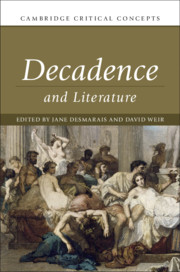Book contents
- Decadence and Literature
- Cambridge Critical Concepts
- Decadence and Literature
- Copyright page
- Dedication
- Contents
- Figures
- Contributors
- Acknowledgements
- Introduction
- Part I Origins
- Part II Developments
- Chapter 8 Decadence and the Visual Arts
- Chapter 9 Decadence and Music
- Chapter 10 Decadence, Parody, and New Women’s Writing
- Chapter 11 The Philosophy of Decadence
- Chapter 12 The Sexual Psychology of Decadence
- Chapter 13 The Theology of Decadence
- Chapter 14 The Science of Decadence
- Chapter 15 The Sociology of Decadence
- Part III Applications
- Select Bibliography
- Index
- References
Chapter 10 - Decadence, Parody, and New Women’s Writing
from Part II - Developments
Published online by Cambridge University Press: 12 August 2019
- Decadence and Literature
- Cambridge Critical Concepts
- Decadence and Literature
- Copyright page
- Dedication
- Contents
- Figures
- Contributors
- Acknowledgements
- Introduction
- Part I Origins
- Part II Developments
- Chapter 8 Decadence and the Visual Arts
- Chapter 9 Decadence and Music
- Chapter 10 Decadence, Parody, and New Women’s Writing
- Chapter 11 The Philosophy of Decadence
- Chapter 12 The Sexual Psychology of Decadence
- Chapter 13 The Theology of Decadence
- Chapter 14 The Science of Decadence
- Chapter 15 The Sociology of Decadence
- Part III Applications
- Select Bibliography
- Index
- References
Summary
As a self-reflexive conceptual category that works by inverting and unsettling commonly held assumptions, decadence has much in common with the device of parody. In England in the early 1890s the self-conscious self-mockery of decadents, dandies, and New Women writers gestured to a robustness and broadening of the decadent tradition. Those New Women writers who used the unorthodoxies of decadence to align themselves against a conservative press did so chiefly via the early volumes of the decadent periodical The Yellow Book between 1894 and 1895. Paradoxically, through the exaggerated appropriation of features of male decadent writing ? egoism, sexual expressiveness, homosexuality ? New Women writers declared their independence from patriarchal literary convention. This chapter discusses the contributions to the Yellow Book of Ella D’Arcy, Ada Leverson, and Victoria Cross, who wrote with a heightened sexual consciousness and a profound sense of disenchantment with contemporary culture in order to raise feminist concerns about sexuality, class, and race.
- Type
- Chapter
- Information
- Decadence and Literature , pp. 169 - 183Publisher: Cambridge University PressPrint publication year: 2019
References
- 1
- Cited by

